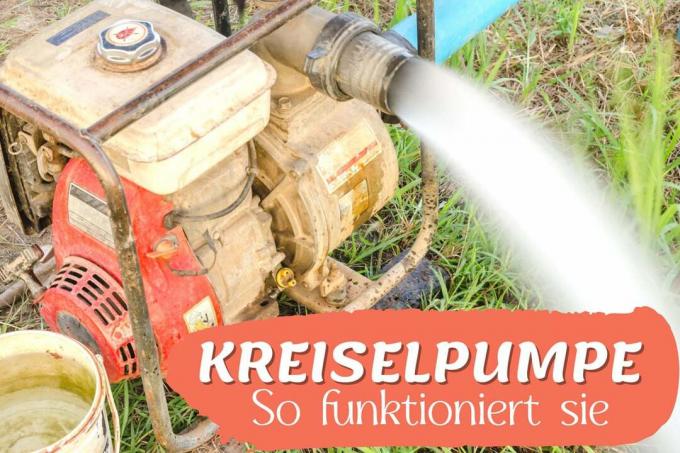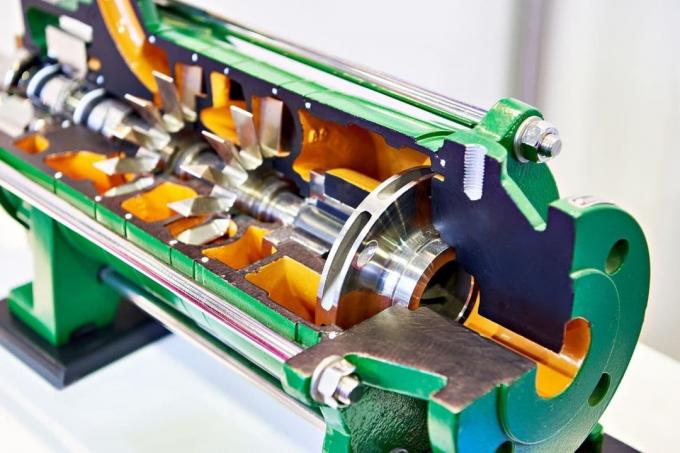
table of contents
- Centrifugal pumps: how they work
- Self-priming pump: how it works
- frequently asked Questions
Centrifugal pumps are among the most popular garden pumps. How this particular garden pump works is not clear to everyone. This article explains how it works.
In a nutshell
- Centrifugal pumps use centrifugal forces
- generate negative pressure
- are not self-priming
- Side channel pumps are self-priming
Centrifugal pumps: how they work
The function of the centrifugal pump is easier than expected. It uses centrifugal forces, which create pressure inside the housing and thus pump water. Due to the way centrifugal pumps work, it is necessary that they are already in contact with water or another fluid. Since you cannot suck in the medium yourself, direct contact is important. For this reason, many centrifugal pumps are filled as a before use Submersible pump that is permanently placed in the water. As soon as the medium is available and there is no oxygen in the housing, the centrifugal pump can work. It must be vented before use. The following guide explains how it works:
- The pump is switched on
- Impellers begin to rotate
- rotate around drive shaft
- Water in the housing is moved
- Rotation creates pressure
- negative pressure in the center
- overpressure on the outside
- Water is pressed against the housing wall by centrifugal forces
- then through openings (e.g. Exhaust valves)

If the pump is not switched off, it continues to work continuously and pumps water until there is not enough water left. Centrifugal pumps do not work without a medium. Depending on the design of the pump, the medium is moved in different directions, which affects the delivery options. The main issue here is the position of the impeller in relation to the axis of rotation:
- axial
- radial
- semi-axial
- parallel
You therefore determine the type of centrifugal pump and the possible applications. The following garden pumps are most commonly used:
- Axial pump: for low-viscosity media
- Radial pump: for viscous media
Note: Because of the way they work, centrifugal pumps are comparable to centrifugal pumps.
Self-priming pump: how it works
There are self-priming Garden pumpsbased on the concept of a centrifugal pump. They are offered under the name of side channel pumps and use an extended mode of operation. You don't have to worry about oxygen or other gases in the device. They easily suck in and move the medium, even when there are significant amounts of gases. This is possible through the combination of a flow pump (centrifugal pump) and positive displacement pump. Compared to centrifugal pumps, they cannot transport solids, which must be taken into account when using them.

The function in detail:
- have an additional paddle wheel in front of the impeller
- The paddle wheel is spiral shaped
- The pump is switched on
- Water and gases are moved in the same way as with centrifugal pumps
- Water is pushed into side channels by pressure
- Side channels transport water to the impeller and further
- Gases are diverted separately
- a liquid ring is used behind the paddle wheel for this purpose
Note: Another form of self-priming garden pumps is the jet pump, which is not based on centrifugal pumps. It does not use any moving parts to transport water and is therefore low-maintenance.
frequently asked Questions
Not exclusively. You can only move solids within the fluid. This means that small stones or debris, for example, are transported and do not damage the centrifugal pump. Since the solids in the water only come into contact with the impeller and housing, they can be used for the transport of solids without hesitation. The ball passage indicates the maximum diameter for solids in millimeters.
Yes, especially if they are used without a solids filter or specifically for pumping liquids with solids. The solids wear the impellers heavily, which makes it necessary to check them at regular intervals and replace them if necessary.
The venting of centrifugal pumps is essential, as even small amounts of air significantly worsen the effect. Already at eight to ten percent the performance of the garden pump is noticeably worse. In some models, they even fail completely because the air component can no longer build up enough pressure.

